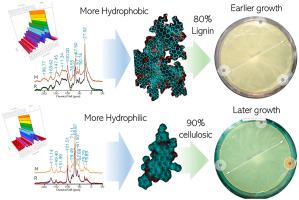Fungal Biology ( IF 2.9 ) Pub Date : 2021-05-30 , DOI: 10.1016/j.funbio.2021.05.006 Thainá Louzada Dos Santos 1 , Orlando Carlos Huertas Tavares 1 , Samuel de Abreu Lopes 1 , Sael Sánchez Elias 1 , Ricardo Luiz Louro Berbara 1 , Andrés Calderín García 1

|
White-rot fungi (Pleurotus eryngii) are decomposers of lignocellulosic substrates. The relationship between the structure of humified organic matter and P. eryngii growth, is poorly understood. This study aimed to evaluate the relationship between the growth and development of white-rot fungi (P. eryngii) in two structurally different sources of humified organic matter. Fungus growth and development (mycelium diameter, fresh and dry mycelium mass, mycelium density, and biological yield) were evaluated in experiments with the application of humic substances (HS) extracted from vermicompost (VC) and peat. Both HS were characterized by CP/MAS 13C NMR spectroscopy associated with chemometrics analysis. The HS present different structural characteristics, with those extracted from VC having a predominance of functionalized C-aliphatics (carbohydrates), low hydrophobicity, and a 90% proportion of cellulose/hemicellulose carbon in the composition. HS extracted from peat have a predominance of C-aromatics (lignin fragments), higher hydrophobicity, and a proportion of lignin carbon of up to 80%. The results showed that P. eryngii growth is dependent on the C-cellulosic and C-lignin balance. HS extracted from lignin-rich peat regulates the fungus growth at initial times and sometimes inhibits the biological performance. The highly cellulosic HS from VC regulate the fungus growth at later times and its biological performance.
中文翻译:

有机质结构对热带气候下白腐菌杏鲍菇生长的环境影响
白腐真菌(Pleurotus eryngii)是木质纤维素底物的分解者。腐殖化有机质的结构与杏鲍菇生长之间的关系知之甚少。本研究旨在评估白腐真菌(P. eryngii) 在两种结构不同的腐殖化有机质来源中。在应用从蚯蚓堆肥 (VC) 和泥炭中提取的腐殖质 (HS) 的实验中评估了真菌的生长和发育(菌丝直径、新鲜和干菌丝质量、菌丝密度和生物产量)。两种 HS 均通过与化学计量学分析相关的 CP/MAS 13C NMR 光谱表征。HS 呈现出不同的结构特征,其中从 VC 中提取的那些具有官能化的 C-脂肪族(碳水化合物)、低疏水性和组合物中 90% 比例的纤维素/半纤维素碳。从泥炭中提取的 HS 以 C-芳烃(木质素碎片)为主,疏水性更高,木质素碳比例高达 80%。结果表明,杏鲍菇生长取决于 C-纤维素和 C-木质素的平衡。从富含木质素的泥炭中提取的 HS 在初始阶段调节真菌的生长,有时会抑制生物性能。来自 VC 的高纤维素 HS 可调节真菌在后期的生长及其生物学性能。











































 京公网安备 11010802027423号
京公网安备 11010802027423号